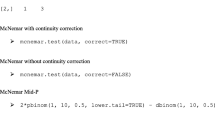All diversity indices are functions of the vector of the numbers of individuals in different species in a statistical population. So they are also functions of the number of species. It is well known, from the species-area curve and from collector's curves, that the number of species is a function of sampling effort. The rarefaction and Coleman functions are both functions that allow comparisons to be made at the same number of individuals, but have different mathematical forms. We show that the numerical difference between them, in the samples we have studied, is negligibly small. We show how to modify the Coleman function to allow for sampling without replacement, and show that the modified function is identical to the hypergeometric rarefaction function. Rarefaction should always be used, with any index, when comparing diversity in different size samples, but the number of species is the preferred index. Suggestions for comparing rarefaction curves from different samples are made.
Similar content being viewed by others
References
Alroy J. (1992) Conjunction among taxonomic distributions and the Miocene mammalian biochronology of the Great Plains. Paleobiology 18, 326–43.
Brewer, A.M. (1992) Modelling the Great American Biotic Interchange. Unpublished M.Sc. thesis, University of York.
Coleman B.D. (1981) On random placement and species-area relations. Mathemat. Biosci. 54, 191–215.
Coleman B.D., Mares M.A., Willig M.R. and Hsieh Y.H. (1982) Randomness, area, and species richness. Ecology 63, 1121–33.
Fager E.W. (1972) Diversity: a sampling study. Am. Natural. 106, 293–310.
Foote M. (1992) Rarefaction analysis of morphological and taxonomic diversity. Paleobiology 18, 1–16.
Grassle J.F. and Maciolek N.J. (1992) Deep-sea species richness: regional and local diversity estimates from quantitative bottom samples. Am. Natural. 139, 313–41.
Hart D.D. and Horwitz R.J. (1991) Habitat diversity and the species-area relationship: alternative models and tests. In Habitat Structure (S.S. Bell, E.D. McCoy and H.R. Mushinsky, eds) pp. 47–68. London: Chapman and Hall.
Heck K.L.Jr., van Beelle G. and Simberloff D. (1975) Explicit calculation of the rarefaction diversity measurement and the determination of sufficient sample size. Ecology 56, 1459–61.
Hill M.O. (1973) Diversity and evenness: a unifying notation and its consequences. Ecology 54, 427–32.
Hurlbert S.H. (1971) The non-concept of species diversity: A critique and alternative parameters. Ecology 52, 577–86.
Kempton R.A. (1979) The structure of species abundance and measurement of diversity. Biometrics 35, 307–21.
Raup D.M. (1975) Taxonomic diversity estimation using rarefaction. Paleobiology 1, 333–42.
Sanders H.L. (1968) Marine benthic diversity: a comparative study. Am. Natural. 102, 243–82.
Siegel A.F. (1990) Rarefaction curves. In Encyclopedia of statistical sciences (S. Kotz and N.L. Johnson, eds) Volume 7, pp. 623–6. New York: John Wiley and Sons.
Siegel A.F. and German R.Z. (1982) Rarefaction and taxonomic diversity. Biometrics 38, 235–41.
Smith W. and Grassle J.F. (1977) Sampling properties of a family of diversity measures. Biometrics 33, 283–92.
Tipper J.C. (1979) Rarefaction and rarefiction—the use and abuse of a method in paleoecology. Paleobiology 5, 423–34.
Williamson M. (1988) Relationship of species number to area, distance and other variables. In Analytical Biogeography (A.A. Meyers and P.S. Giller, eds) pp. 91–115. London: Chapman and Hall.
Author information
Authors and Affiliations
Rights and permissions
About this article
Cite this article
Brewer, A., Williamson, M. A new relationship for rarefaction. Biodivers Conserv 3, 373–379 (1994). https://doi.org/10.1007/BF00056509
Received:
Accepted:
Issue Date:
DOI: https://doi.org/10.1007/BF00056509




